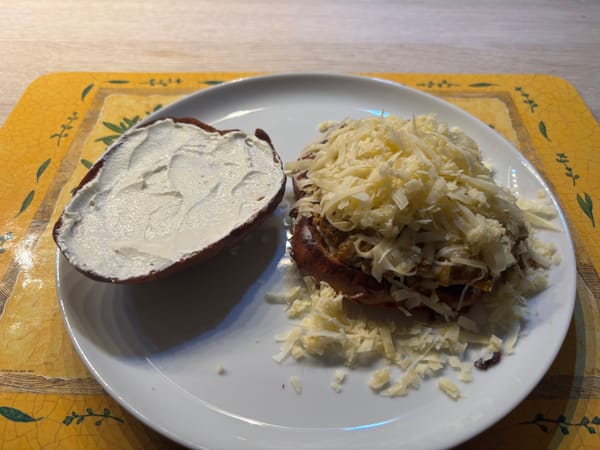Here's something interesting: the immediate environment, in which cancer tumours grow, is more acidic than the surrounding healthy tissue. This is will known as the acidic tumour microenvironment (1).
Why do I tell you this? Well, because there've been studies made on supplementation of alkalising (meaning anti-acidic) agents actually helping inhibit cancer tumour invasion into and damaging of healthy tissue (2–3). Neutralisation of the tumour microenvironment has also been found to inhibit metastasis (spread throughout the body) and even put cancer cells into a state of senescence – meaning a state of inactivity, where the cancer cell no longer grows (4).
And as I always repeat, there's only one type of cancer, which can kill us: a growing one.
So, if this is so promising, why isn't it used immediately for every single cancer patient? I presume it has to do with profitability, which is very poor given the fact, that these alkalising agents are incredibly cheap.
Nonetheless, research exists, which clearly shows, that neutralising the tumour microenvironment can help cancer patients survive (5). So, in this article, we'll dive into just why and how that works before looking at the two alkalising agents, which you can use today to immediately improve your chances of survival.
Tall promise, I know, but I promise to keep it. So, let's get into it.
Firstly, I think it's important to understand where this acidic tumour environment comes from. One of the hallmarks of cancer is an impaired metabolism, which shifts away from the oxygen-using and efficient cellular respiration to the non-oxygen-using and about 15-times less efficient cellular fermentation (6–8). Why do cancer cells do this?
The exact sequence of events differs in different cancers, but most cancer seem to begin with one of two things, which promotes this cellular fermentation: either they incur damage to their mitochondria – the cellular compartments, which are responsible for cellular respiration –, so that these no longer can generate enough energy for the cell and the burgeoning cancer cell uses more and more cellular fermentation to compensate, or they come across a sustained period of oxygen deficiency, which disallows sufficient energy production by way of cellular respiration, which in turn forces the cell to use cellular fermentation to compensate.
Both these processes are good and should occur. The problem, however, arises, when the given conditions become chronic in nature. Meaning, it's good, that cells compensate for lack of oxygen-using energy production by using cellular fermentation, but only in the short term. If this behaviour is not corrected by healing of mitochondrial damage and normalising the supply of oxygen, the environment around the cells in question becomes acidic. But how?
Well, both these paths – mitochondrial damage and oxygen deficiency – promote cellular fermentation and cellular fermentation is inefficient both in energy production and waste generation (9–12). So, whilst both the waste products of cellular respiration and cellular fermentation are acidic in nature, given the waste-inefficient nature of cellular fermentation, a cell in using fermentation will excrete a far larger amount of acidic waste.
We publish new articles, whenever we've synthesised new findings to a usable degree. You can subscribe to receive articles for free.
But it gets worse still. Our blood is incredibly efficient at transporting oxygen and the waste product from cellular respiration – carbon dioxide –, but it's far less efficient at transporting the waste product from cellular fermentation – lactic acid (13–14).
So, you now have a cell, which produces far larger amounts of waste product, which are far less efficiently removed from its environment. And these waste products are acidic. I think you can guess what happens to the environment.
Correct! It becomes increasingly acidic.
So far, so good. But why is this even bad? Why is it bad, that the environment around this struggling cell becomes acidic? And what does it have to do with cancer?
Well, a highly acidic tumour microenvironment increases the metabolic flexibility of cancer cells and promotes such cancer hallmarks as invasion (displacement and damaging of healthy tissue), immune evasion (ignoring immune system signals, which would kill normal cells), and metastasis (spread of the cancer throughout the body) (2–3, 15).
It would thus be incredibly valuable, if we could neutralise the tumour microenvironment – meaning, if we could lower its acidity. This neutralisation would both make cancer cells less metabolically flexible – in turn making metabolic interventions more powerful – and also impair the ability of the cancer tumour to kill you. Both are worthy results.
Now, as I've mentioned at the start we can absolutely neutralise the tumour microenvironment. And we don't even need expensive treatments or pharmaceuticals for it. So, let's look at the two alkalising agents, which are known to be able to neutralise the tumour microenvironment.
The two alkalising agents I have in mind are the incredibly cheap sodium bicarbonate and trisodium citrate. Both are used and produced in large quantities globally, both for industry and food use. You probably know sodium bicarbonate better as baking soda. Trisodium citrate is a flavouring and preservative agent used in sodas and many other things (known as E331 in these contexts).
Interestingly, both compounds are used as interventions for human ailments already. Both sodium bicarbonate and trisodium citrate are used to treat metabolic acidosis (16).
Metabolic acidosis is just a fancy term, which describes the precisely same thing, as I've described at length above: the highly acidic environment caused by overly active fermentation over long periods, which eventually leads to an acid-base imbalance, giving us the acidic tumour microenvironment.
Yes, you read that right. WE ALREADY USE SODIUM BICARBONATE AND TRISODIUM CITRATE TO TREAT THE VERY SYMPTOM, WHICH HELPS CANCER TUMOURS KILL US. I honestly have no words for this insanity. So, instead of harping on about my disappointment with the system, let me instead lay out the functionality of sodium bicarbonate and trisodium citrate in neutralising the acidic tumour microenvironment and follow up with dosage ranges for effective neutralisation.
As trisodium citrate is rapidly metabolised and provides three equivalents of sodium bicarbonate (17). It thus has the precisely same mechanism of action as does sodium bicarbonate, being about equally potent as an alkalising agent per weight ingested as is sodium bicarbonate (calculated from molecular weights and milliequivalents of alkali). I will thus go over the function of sodium bicarbonate, then talk dosage and side effects for both compounds.
We don't take sponsoring or display advertisements in order to keep us free from conflicts of interest. If you've found this valuable, you can help us by supporting our fight against cancer financially.
Sodium bicarbonate is absorbed from the gut directly into the blood as sodium and bicarbonate in aqueous solution. When the bicarbonate is now transported by blood to areas of high acidity, it sequesters H+ (can be understood as the smallest unit of acidity) (1, 18). After sequestering H+ and thus lowering acidity, it can be breathed out as carbon dioxide in the lungs, leaving water in the blood. Since it's active as an alkalising agent, specifically where the environment is acidic, the tumour microenvironment is implicitly targeted by use of simple chemistry.
Sodium bicarbonate is extremely tolerable, but should be used with care in patients with kidney insufficiency. For everyone else it can be supplemented without problems at 0.2 g/kg of bodyweight daily (18). Taking it in multiple doses is probably good. As it partially weakens stomach acid, it's recommendable to not ingest it less than an hour before food and two hours after food.
Also, since sodium bicarbonate can cause bloating, the use of trisodium citrate may be preferable. It too partially weakens stomach acid, but does not lead to bloating. If use of trisodium citrate is wished for, the same daily dosage of 0.2 g/kg of body weight can be made with equivalent potency of intervention, but should be avoided, if you ingest aluminium-containing antacids (19).
Furthermore, trisodium citrate has a somewhat citrusy, tart or sour flavour. So, it can be far more palpable than sodium bicarbonate. For both sodium bicarbonate and trisodium citrate smaller daily dosages are probably sufficient. No matter the dose, administration should occur in multiple smaller doses – for example, 4 daily doses of 0.05 g/kg of body weight.
Lastly I'd highly recommend to be wary of side effects, such as nausea, muscle pain and twitching, headache and adjust dosage accordingly. Also, daily dosage of up to 0.3 g/kg of body weight seem safe, though single doses probably shouldn't exceed 0.05 g/kg of body weight.
This has been a long article, I know. I tried to shorten it as much as possible, explaining only what I found necessary to understand background, efficacy, safety, and dosage, but it has become quite the expansive article, nonetheless.
I hope, that it gives you some direction and yet another weapon in your arsenal for your fight against cancer.
May God bless you with much health and lasting healing,
Merlin.
References
- Basta, T. (2024). Sodium Bicarbonate: Potential Cancer Therapy. Journal of Hunan University Natural Sciences.
- Hao, G., Xu, Z.P., and Li, L. (2018). Manipulating extracellular tumour pH: an effective target for cancer therapy. RSC Advances 8, 22182-22192. 10.1039/C8RA02095G.
- Pillai, S.R., Damaghi, M., Marunaka, Y., Spugnini, E.P., Fais, S., and Gillies, R.J. (2019). Causes, consequences, and therapy of tumors acidosis. Cancer Metastasis Rev 38, 205-222. 10.1007/s10555-019-09792-7.
- Zhao, Y., Liu, X., Si, F., Huang, L., Gao, A., Lin, W., Hoft, D.F., Shao, Q., and Peng, G. (2022). Citrate Promotes Excessive Lipid Biosynthesis and Senescence in Tumor Cells for Tumor Therapy. Advanced Science 9, 2101553. 10.1002/advs.202101553.
- Hamaguchi, R., Isowa, M., Narui, R., Morikawa, H., and Wada, H. (2022). Clinical review of alkalization therapy in cancer treatment. Frontiers in Oncology Volume 12 - 2022. 10.3389/fonc.2022.1003588.
- Potter, M., Newport, E., and Morten, K.J. (2016). The Warburg effect: 80 years on. Biochem Soc Trans 44, 1499-1505. 10.1042/bst20160094.
- Seyfried, T.N., and Chinopoulos, C. (2021). Can the Mitochondrial Metabolic Theory Explain Better the Origin and Management of Cancer than Can the Somatic Mutation Theory? Metabolites 11.
- Seyfried, T.N., and Shelton, L.M. (2010). Cancer as a metabolic disease. Nutrition & Metabolism 7, 7 - 7.
- Alberts, B., Johnson, A., Lewis, J., Morgan, D., Raff, M., Roberts, K., and Walter, P. (2015). Cell Chemistry and Bioenergetics. In Molecular Biology of the Cell, (Garland Science, Taylor & Francis Group, LLC), pp. 43-108.
- Alberts, B., Johnson, A., Lewis, J., Morgan, D., Raff, M., Roberts, K., and Walter, P. (2015). Cancer. In Molecular Biology of the Cell, (Garland Science, Taylor & Francis Group, LLC), pp. 1091-1144.
- Alberts, B., Johnson, A., Lewis, J., Morgan, D., Raff, M., Roberts, K., and Walter, P. (2015). Energy Conversion: Mitochondria and Chloroplasts. In Molecular Biology of the Cell, (Garland Science, Taylor & Francis Group, LLC), pp. 753-812.
- Wohl, I., and Sherman, E. (2019). ATP-Dependent Diffusion Entropy and Homogeneity in Living Cells. Entropy 21.
- Chatzinikolaou, P.N., Margaritelis, N.V., Paschalis, V., Theodorou, A.A., Vrabas, I.S., Kyparos, A., D'Alessandro, A., and Nikolaidis, M.G. (2024). Erythrocyte metabolism. Acta Physiologica 240, e14081. 10.1111/apha.14081.
- Doyle J, C.J. (2023). Physiology, Carbon Dioxide Transport. Available from: https://www.ncbi.nlm.nih.gov/books/NBK532988/
- Rolver, M.G., Holland, L.K.K., Ponniah, M., Prasad, N.S., Yao, J., Schnipper, J., Kramer, S., Elingaard-Larsen, L., Pedraz-Cuesta, E., Liu, B., et al. (2023). Chronic acidosis rewires cancer cell metabolism through PPARα signaling. International Journal of Cancer 152, 1668-1684. 10.1002/ijc.34404.
- Chen, W., and Abramowitz, M.K. (2014). Treatment of metabolic acidosis in patients with CKD. Am J Kidney Dis 63, 311-317. 10.1053/j.ajkd.2013.06.017.
- Ando, H., Eshima, K., and Ishida, T. (2021). Neutralization of Acidic Tumor Microenvironment (TME) with Daily Oral Dosing of Sodium Potassium Citrate (K/Na Citrate) Increases Therapeutic Effect of Anti-cancer Agent in Pancreatic Cancer Xenograft Mice Model. Biological and Pharmaceutical Bulletin 44, 266-270. 10.1248/bpb.b20-00825.
- Senewiratne NL, W.A., Can AS. Sodium Bicarbonate. Available from: https://www.ncbi.nlm.nih.gov/books/NBK559139/.
- Chen, W., and Abramowitz, M.K. (2014). Treatment of metabolic acidosis in patients with CKD. Am J Kidney Dis 63, 311-317. 10.1053/j.ajkd.2013.06.017.









